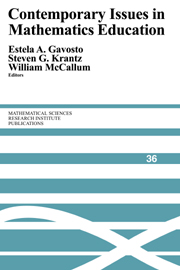Book contents
Keynote Address: Mathematicians as Educators
Published online by Cambridge University Press: 27 June 2025
Summary
The mathematical sciences professions are in a phase transition, from which they may well emerge smaller, and/or redistributed and much more dispersed. We are not an endangered species, but our health depends on being able to transcend our historic tendencies toward insularity and on our outreach to all of our sister and client communities. This message, in diverse forms, is widely heard today.
The internal mathematical culture continues its deep investigation of the fundamental structures of number, space, dynamics, now with the added exploratory and processing power of new technology. These investigations are guided partly by purely intellectual evolution, but largely also by the natural sciences, to which mathematics furnishes the language and concepts for description, analysis, and modeling. In addition, mathematics provides design and simulation tools for engineering, technology, and for the organization and decision processes of industry. These diverse functions of mathematical thinking and tools are increasingly manifest in many professions, and across the technical workforce.
The phase transition mentioned above involves many partial shifts of focus — from core mathematics toward applications and toward interdisciplinary work with the natural and social sciences, from academic to industrial and laboratory settings, from individual self-directed work to collaborative and multidisciplinary effort, from technical communication with co-specialists to translational communication across disciplinary and cultural boundaries.
Information
- Type
- Chapter
- Information
- Contemporary Issues in Mathematics Education , pp. 1 - 6Publisher: Cambridge University PressPrint publication year: 1999
